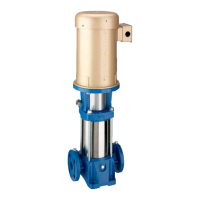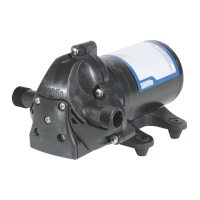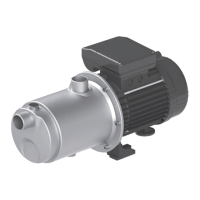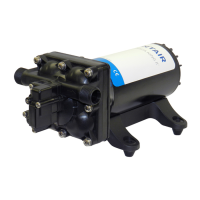7
MODELS 411 & 481, 412, 413 & 483
6. Install packing or mechanical seals and secure according to
the following specific instructions.
STANDARD PACKING
a. Slide a bushing (56) onto each end of shaft. The
raised shoulder on these bushings must face away from
impeller.
b. Pump sizes 2 x 2-1/2 x 9, 2 x 2-1/2 x 10, 2 x 2-1/2 x
12 have one packing ring (23) in front of lantern ring
(52). All other pump sizes have two packing rings in
front of lantern ring. Stagger the joints in packing rings
so pump will not leak excessively.
MECHANICAL SEALS
a. Single seal and balanced single seals
I. Slide one seal lock collar (54) with setscrews (55)
facing the impeller onto each end of the shaft. Position
on scribe mark made during disassembly and lock in
place.
II. Put a light coat of liquid dishwashing detergent on
the shaft sleeve. Check rotating parts of seal to make
sure they are clean. Spread a light coat of liquid deter
gent on inside diameters of flexible bellows and wash
ers.
III. Place the seal’s spring, drive ring, retai
ner, flexible
bellows, and washer on the shaft sleeve in respective
order. (Refer to figure 1)
IV. Thoroughly inspect cavity of seal gland (49) for
burrs or nicks which would damage seat of the seal.
Apply a film of liquid detergent to seal seat and install it
in seal gland cavity, taking care to seat it evenly and
squarely.
NOTE
If it is not possible to insert the seat with fingers, place a card-
board protecting ring (furnished with seal) over lapped face of
seat and press into pla
ce with a piece of tubing having end cut
square. Tubing should be slightly larger than the diameter of the
shaft. Remove coardboard after the seat is firmly in place.
Never place a mechanical seal into service after it has been used
without replacing or relapping stationary seat and washer faces.
V. Place O-rings (50) around the seal glands and slide
seal glands onto the ends of the shaft.
b. Double Seal
I. Place one seal seat in collar (54), the other one fits
into seal gland (49).
These parts are set into their cavi
ties in the same manner as they are with a single seal.
II. Place o-rings (51) around collars (54) and put the
collars with stationary seats facing away from impeller
on ends of the shaft, then slide flexible bellows, wash-
ers, and springs on the shaft in order shown in figure 1,
for each half of double seal assembly (53).
III. Place o-rings (50) around the seal glands (49) and
slide seal glands onto ends of the shaft with stationary
seats facing i
mpeller.
7. Place slinger (39) on outboard end of shaft.
8. Press grease seal (37) into bearing cartridge (36). On 6B, 7A
and 7 Power Frames replace snap ring (35A) on inboard slide of
bearing. Place outboard double row ball bearing (38) in bearing
cartridge and press these parts onto outboard end of the shaft.
Snap retainer ring (35) in place to secure outboard bearing.
Place gasket (43) and cartridge cap (32) in position and secure
with capscrews (31).
NOTE
Model 412, 413 & 483
- Both the grease zerk holes in bearing
cartridges and the pipe plugholes in cartridge caps must be fac-
ing the front of pump when it is assembled.
9. Protector (29) can be placed in the cartridge cap or, if unit has
a tandem shaft, press grease seal into cartridge cap and slide a
slinger onto shaft.
10. Place slinger (48) on inboard end of the shaft.
11. Press grease seal (46) into bearing cartridge (45). Place the
inboard bearing (47) into the bearing cartridge and press this
asse
mbly onto inboard end of the shaft.
12. Press grease seal (43) into cartridge cap (42). Position gas-
ket (44) and cartridge cap against bearing cartridge and secure it
in place with capscrews (41). Be sure to align grease zerk hole
and pipe plughole to the front.
13. Place slinger (40) onto shaft. Place grease zerks (10) in bear-
ing cartridges and pipe plugs (12) in bearing caps. If pump is
oil lubricated, breather tubes are placed in bearing cartridges
and oilers with nipples
and elbows are placed in cartridge caps.
14. Slide casing wearing rings (28) over impeller wearing rings
(61) and set rotating elements into casing halves (69). Make
certain the holes that are drilled in bottom of surface of casing
wearing rings locate over pins (66) previously set in casing
half (69). Grease zerks or breather tube should face outward.
15. Install key (24) in motor end of shaft (65). Check position
ing and alignment of packing rings or seal components and
inst
all swing bolts (22) and split gland halves (21) if the pump
has packing. Place in position clamps (20), washers (19), and
nuts (18) securing loosely in place. Swing bolts (22) are set
over pins (68) on 4x5x10 or smaller pumps. On larger pumps
swing bolts are held in place by capscrews (7) after casing half
(8) is in position.
16. Place pins (27) into bearing cartridges. Place bearing caps
(26) in position and secure with capscrews (25)
17. Position new casing gaskets (9) on casin
g half (69). Set
casing half (8) in place and secure it to casing half (69) with
capscrews (6). Pins (67) are used as means of locating position
of the two casing halves.
18. On pumps larger than 4x5x10, thread in capscrews (7) mak-
ing sure they are placed through the eyes of swing bolts (22).
19. Place drain plugs (1) and (2) back in the casing halves.
CAUTION

